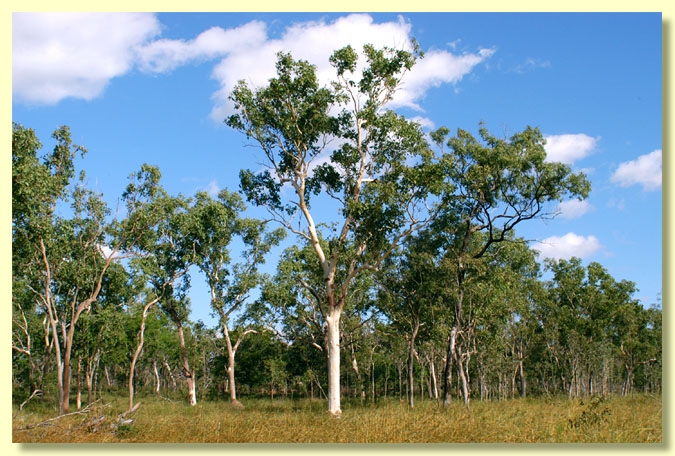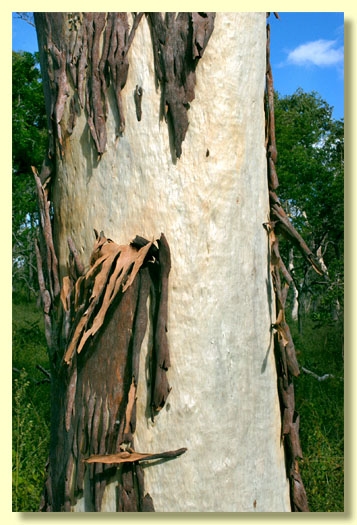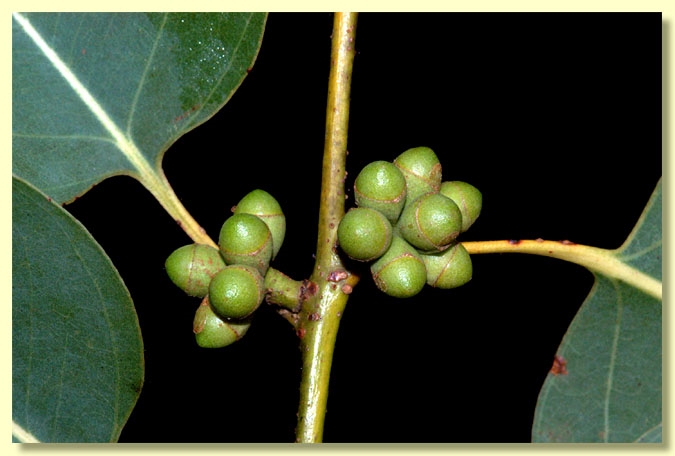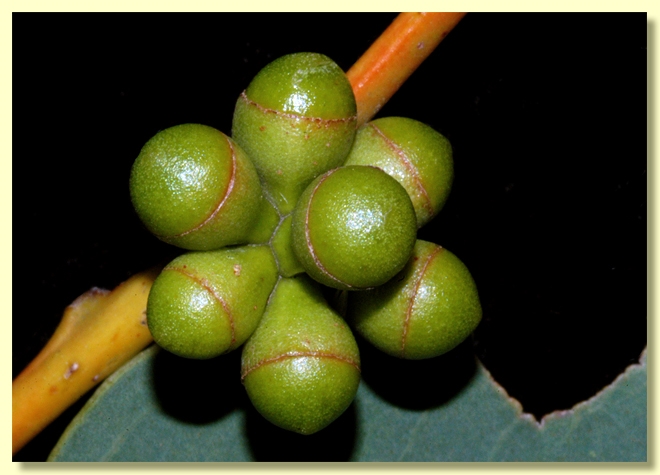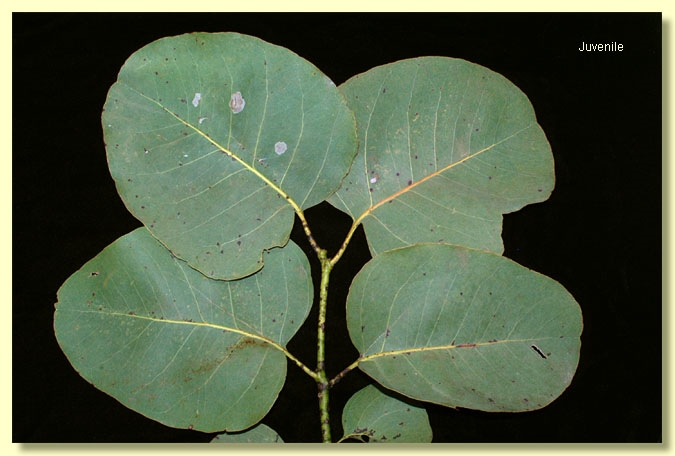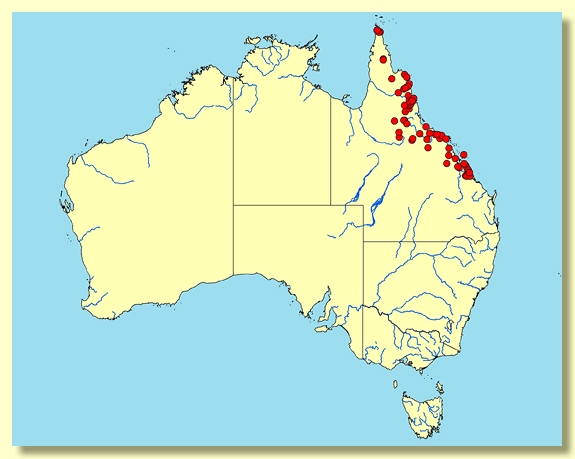Euclid - Online edition
Eucalyptus platyphylla
Eucalyptus | Symphyomyrtus | Exsertaria | Subexsertae | Applanatae
Eucalyptus platyphylla F.Muell., J. Proc. Linn. Soc., Bot. 3: 93 (1859).
T: Upper Burdekin River, Queensland, 14 Oct. 1856, F.Mueller; holo: MEL.
Tree to c. 20 m tall, often deciduous during the hotter drier months prior to the wet season. Forming a lignotuber.
Bark smooth and sometimes powdery, new bark pale pink to creamy-white to greenish-white, maturing to white and weathering to grey or reddish brown just before decortication.
Juvenile growth (coppice or field seedlings to 50 cm): stems square to round in cross-section, not glaucous; juvenile leaves always petiolate, sub-opposite to alternate, deltoid, 9–20 cm long, 6–16.5 cm wide, base broadly lobed to truncate to rounded, green.
Adult leaves alternate, petioles 2.5–7 cm long; blade orbicular to cordate to ovate to rarely broadly lanceolate, 5–21 cm long, 3.5–12 cm wide, base truncate to rounded to tapering to petiole, margin entire, apex pointed to rounded, concolorous, dull grey-green to green, side-veins acute or at a wider angle than 45° to the midrib, reticulation very dense, intramarginal vein present, oil glands small, mostly intersectional, rarely island.
Inflorescence axillary unbranched, peduncles 0.3–0.8(1) cm long, buds per umbel 7, sessile to shortly pedicellate (pedicels 0–0.2(0.6) cm long). Mature buds obovoid to globular, 0.6–0.9 cm long, 0.5–0.7 cm wide, scar present, operculum rounded to conical (0.25–0.5 cm long), hypanthium sometimes with two longitudinal ridges, stamens irregularly flexed, anthers oblong, versatile, dorsifixed, dehiscing by longitudinal slits, style long and straight, stigma blunt, locules (3)4, the placentae each with 6 or more vertical rows of ovules. Flowers white.
Fruit sessile to shortly pedicellate (pedicels 0–0.3 cm long), obconical to hemispherical, non-glaucous, 0.3–0.6 cm long, 0.6–1 cm wide, disc raised and annular, valves (3)4, exserted or near the rim.
Seeds brown, 1.5–2 mm long, ± flattened ovoid to rarely pyramidal, dorsal surface shallowly reticulate, edge of seed with small sharp teeth, hilum ventral.
Cultivated seedlings (measured at ca node 10): not seen
Flowering has been recorded in June, July, September and October.
A medium-sized tree, occurring in the savannah woodlands and open forest areas of the coastal strip of eastern Queensland from Horn Island in the Torres Strait region at the tip of Cape York Peninsula, south through the drier western parts of the Atherton Tablelands extending southwards as far as the Mt Garnet – Greenvale – Charters Towers area, then back to the coastal areas as far south as Rockhampton. Characterised by the smooth, powdery, usually white bark, the broad ovate to orbicular to deltoid adult leaves, the obovoid to globular buds and hemispherical to obconical fruit with a raised annular disc and prominently exserted valves.
Eucalyptus platyphylla belongs to a small group of species closely related to the red gums. This group is distinguished by having smooth powdery bark, adult leaves with dense to very dense venation and intersectional or absent oil glands, buds with inflexed stamens, fruit with an annular disc and more or less flattened, toothed seeds with a ventral hilum. Other members of this group are E. bigalerita, E. alba, E. tintinnans, E. apodophylla and E. houseana.
Within this group, E. platyphylla, with its broadly ovate to orbicular to deltoid adult leaves,is closest to E. bigalerita and E. tintinnans and is only weakly separated from both. There appears to be very little difference between E. platyphylla and E. bigalerita worthy of mention (see note below). It differs from E. tintinnans by being a much taller, better formed tree with larger fruit, usually wider than 0.6 cm (E. tintinnans is usually a poorly formed tree from the stony rises in the southern part of the Top End of the Northern Territory, with fruit 0.6 cm or slightly narrower). It is also very close to E. alba var. australasica from the Top End of the Northern Territory and the Kimberley in Western Australia and is separated by the width of the adult leaves (usually wider than 5 cm in E. platyphylla and less than 5 cm in E. alba; however, there is some overlap, with some individuals from both taxa falling outside this criterion). It is separated from E. houseana by having slightly larger fruit (fruit normally 0.6 cm or wider in E. platyphylla but for E. houseana, 0.5 cm or narrower). E. apodophylla differs by having opposite, blue-grey to glaucous, sessile to shortly petiolate adult leaves (always distinctly petiolate, alternate and dull green to grey-green in E. platyphylla).
E. hallii, from the Bundaberg–Maryborough district in south-east Queensland and E. broviniensis from the Mundubberra district also in south-east Queensland, are two closely related white gums. They are at present placed in the series Connexentes. E. platyphylla can be separated from both by having wider, ovate to orbicular to deltoid (rarely broadly lanceolate) adult leaves, usually wider than 4.5 cm (E. hallii and E. broviniensis with broadly lanceolate to lanceolate adult leaves, usually narrower than 4.5 cm).
Within its area of occurrence, E. platyphylla may be confused with some red gum eucalypts with white smooth bark, i.e. E. tereticornis, E. camaldulensis var. obtusa and E. camaldulensis subsp. simulata, and to a lesser extent, the ghost gums C. grandifolia and C. dallachiana. The three red gums are easily separated by having much narrower, lanceolate adult leaves, usually narrower than 3.6 cm and by their long acute operculum. E. platyphylla hybridises with E. tereticornis and E. camaldulensis in some areas where their distribution overlaps (e.g. Palm Island). The two smooth-barked ghost gums are also easily separated by having thin-walled fruit with the valves enclosed.
(The relationships between Eucalyptus alba var. alba, E. alba var. australasica, E. bigalerita, E. hallii, E. platyphylla and E. tintinnans need further investigation. E. alba var. alba, E. bigalerita, E. platyphylla and E. tintinnans are all very similar and the taxonomy, largely based on the size of adult leaves, buds and fruit, does not appear to work across the full range for this group. It maybe better that all four species be placed in one variable taxon, using the oldest name, Eucalyptus alba. Such a revision is beyond the scope of EUCLID, thus we have adopted the current curatorial status for this group).
Eucalyptus platyphylla: Greek platy, broad, wide, and - phyllus, leaved, referring to the broad leaves.

